
The Sipuncula or Sipunculida is a class containing about 162 species of unsegmented marine annelid worms. Sipuncula was once considered a phylum, but was demoted to a class of Annelida, based on recent molecular work.
Polychaeta is a paraphyletic class of generally marine annelid worms, commonly called bristle worms or polychaetes. Each body segment has a pair of fleshy protrusions called parapodia that bear many bristles, called chaetae, which are made of chitin. More than 10,000 species are described in this class. Common representatives include the lugworm and the sandworm or clam worm Alitta.

Isopoda is an order of crustacean, which includes woodlice and their relatives. Members of this group are called Isopods and include both terrestrial and aquatic species. All have rigid, segmented exoskeletons, two pairs of antennae, seven pairs of jointed limbs on the thorax, and five pairs of branching appendages on the abdomen that are used in respiration. Females brood their young in a pouch under their thorax.

Marine life, sea life, or ocean life is the plants, animals, and other organisms that live in the salt water of seas or oceans, or the brackish water of coastal estuaries. At a fundamental level, marine life affects the nature of the planet. Marine organisms, mostly microorganisms, produce oxygen and sequester carbon. Marine life, in part, shape and protect shorelines, and some marine organisms even help create new land.

Spirobranchus giganteus, commonly known as the Christmas tree worm, is a tube-building polychaete worm belonging to the family Serpulidae.

Alitta succinea is a species of marine annelid in the family Nereididae. It has been recorded throughout the North West Atlantic, as well as in the Gulf of Maine and South Africa.

Sabellastarte spectabilis is a species of benthic marine polychaete worm in the Sabellidae family. It is commonly known as the feather duster worm, feather duster or fan worm. It is native to tropical waters of the Indo-Pacific but has spread to other parts of the world. It is popular in aquariums because of its distinctive appearance and its ability to remove organic particles and improve water quality.

Cirratulidae is a family of marine polychaete worms. Members of the family are found worldwide, mostly living in mud or rock crevices. Most are deposit feeders, but some graze on algae or are suspension feeders.

Lanice conchilega, commonly known as the sand mason worm, is a species of burrowing marine polychaete worm. It builds a characteristic tube which projects from the seabed, consisting of cemented sand grains and shell fragments with a fringe at the top.

Arenicolidae is a family of marine polychaete worms. They are commonly known as lugworms and the little coils of sand they produce are commonly seen on the beach. Arenicolids are found worldwide, mostly living in burrows in sandy substrates. Most are detritivores but some graze on algae.

Serpula vermicularis, known by common names including the calcareous tubeworm, fan worm, plume worm or red tube worm, is a species of segmented marine polychaete worm in the family Serpulidae. It is the type species of the genus Serpula and was first described by Carl Linnaeus in his 1767 12th edition of Systema Naturae. It lives in a tube into which it can retract.

Dodecaceria is a genus of marine polychaete worms in the family Cirratulidae.
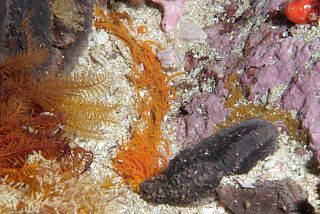
Cirriformia capensis, commonly known as the orange thread-gilled worm, is a species of marine polychaete worm in the family Cirratulidae.

Sabella spallanzanii is a species of marine polychaete worms in the family Sabellidae. Common names include the Mediterranean fanworm, the feather duster worm, the European fan worm and the pencil worm. It is native to shallow waters in the northeastern Atlantic Ocean and the Mediterranean Sea. It has spread to various other parts of the world and is included on the Global Invasive Species Database.
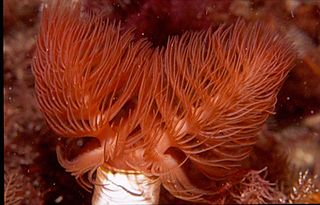
Protula bispiralis, commonly known as the red fanworm or as a mopworm, is a species of marine polychaete worm in the family Serpulidae.
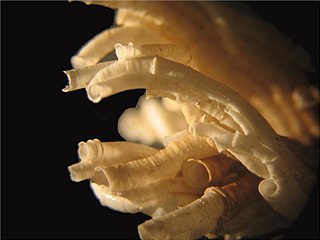
Ficopomatus enigmaticus, commonly known as the Australian tubeworm, is a species of serpulid tubeworms. Their true native range is unknown, but they probably originated in the Southern Hemisphere, perhaps from the Indian Ocean and the coastal waters of Australia. Today they have a cosmopolitan distribution, having been introduced to shallow waters worldwide. The Australian tubeworm is an invasive species that dominates and alters habitats, reduces water quality, depletes resources, and causes biofouling.

Scolelepis squamata is a species of polychaete worm in the family Spionidae. It occurs on the lower shore of coasts on either side of the Atlantic Ocean.
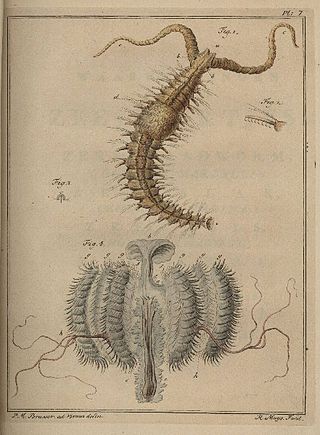
Polydora ciliata is a species of annelid worm in the family Spionidae, commonly known as a bristleworm. It is a burrowing worm and is found in the northeastern Atlantic Ocean and some other parts of the world.

Poecilochaetus serpens is a species of marine polychaete worm in the family Poecilochaetidae. It is a benthic worm that burrows into soft sediment.
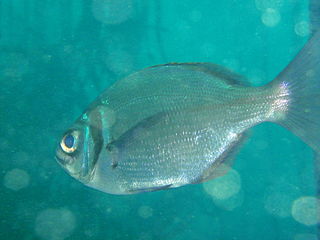
Boopsoidea inornata, the Fransmadam or Karel grootoog, is a species of marine fish in the seabream family of order Perciformes. It is native to the south coast of South Africa.



















